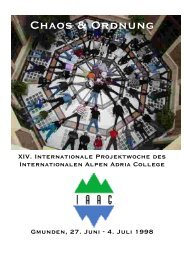ZEITREISEN - IAAC
ZEITREISEN - IAAC
ZEITREISEN - IAAC
Erfolgreiche ePaper selbst erstellen
Machen Sie aus Ihren PDF Publikationen ein blätterbares Flipbook mit unserer einzigartigen Google optimierten e-Paper Software.
with anything in our Universe, he discounted the “mirror universe”.<br />
Kurt Gödel and the Rotating Universe<br />
Kurt Gödel is unquestionably the greatest logician of the 20 th century, which has been the greatest<br />
century for logic since Aristotle’s era. Despite this stature, his name is little known outside<br />
professional circles of logic and mathematics. Part of the cause of his narrower fame probably lies in<br />
the fact that Einstein’s theories were acclaimed as triumphs, while the initial judgment on Gödel’s<br />
theorems was that they constituted a first-rate calamity for logic and mathematics. Namely, Gödel in<br />
1931, at the age of only 25 proved the incompleteness of mathematics. Gödel’s First incompleteness<br />
theorem showed that some perfectly well-formed arithmetical statements could never be proved true<br />
or false. Worse, it showed that some arithmetical truths could never be proved true. Among physicists<br />
Gödel is known as “the man who proved that time travel to the past was possible under Einstein’s<br />
equations”, although this was just a trip outside his field. In 1949 Gödel, working with Einstein at<br />
Princeton, published a paper called “An Example of a New Type of Cosmological Solutions of<br />
Einstein’s Field Equations of Gravitation” (Reviews of Modern Physics, 1949:21;447).<br />
In this paper Gödel described a rotating Universe. There are in fact solutions to Einstein’s field<br />
equations that allow for “closed timelike curves” (CTCs), i.e., curves in space-time that are continuous,<br />
can represent a causal process in time, and that loop back on themselves. Closed timelike curves<br />
would obviously allow for a sort of backwards time travel. In his solution, if the Universe were infinite,<br />
nonexpanding, and were rotating at a certain rate, the forward light cones would bend forward in the<br />
direction of rotation until at a certain critical distance from the center of rotation, they would create a<br />
closed timelike loop around the perimeter of rotation. In such a universe, “a traveler can move around<br />
a circular path on a trip into his local future and end up in his own global past, without ever traveling<br />
faster than light”.<br />
In such a place, if a bullet is fired off from any point, its path will be swung around by the general spin.<br />
In fact, Gödel’s space-time is so distorted by its spin that it contains paths which loop into the past. In<br />
a universe like ours, such paths would be hundreds of millions of light years long, but the paths<br />
shorten if the general density is higher. If a universe with a mass like ours were as Gödel describes, it<br />
would have to rotate once every 70 billion (70 × 10 9 ) years, and the critical radius for the creation of<br />
CTCs would be 16 billion (16 × 10 9 ) light-years from the center of rotation, which is about the edge of<br />
our Universe. However, our Universe is nothing like this.<br />
Einstein in his memoirs wrote that he devoted a lot of thinking to Gödel’s idea. He concluded that the<br />
Universe has been expanding, and not rotating, ever since its creation in Big Bang.<br />
Like in the case of Einstein-Rosen bridge, Einstein concluded that Gödel’s solution can be dismissed<br />
for physical reasons.<br />
Frank Tipler and the Rotating Cylinder<br />
In 1949 Gödel rotated the entire Universe, while Frank Tipler in his approach for building the time<br />
machine reduced the problem merely to the spinning an infinite cylinder.<br />
In 1974 Tipler, a physics graduate student at the University of Maryland, has suggested a variant of<br />
Gödel’s view that describes how one could create closed timelike curves using a rotating, infinitely<br />
long cylinder (“Rotating Cylinders and the Possibility of Global Causality Violation”. Physical Review D<br />
1974:9;2203-2206). One could spiral around the cylinder backwards in time, until one reached any<br />
desired point in the past (except points in time before the creation of the cylinder).<br />
The final sentence in Tipler’s paper says: In short, general relativity suggests that if we construct a<br />
sufficiently large rotating cylinder, we create a time machine.<br />
Nobody had ever before made such a statement in a respectable scientific journal. Fully aware of<br />
difficulty to build such time machine, in his other paper, Tipler suggested the possibility of speeding up<br />
the rotation of an existing star as an alternative approach.<br />
The significance of Tipler’s result, and Gödel’s too (that bothered Einstein) is that they hold up a hope<br />
for the physical possibility of time travel.<br />
<strong>ZEITREISEN</strong> - 16. INTERNATIONALE PROJEKTWOCHE DES <strong>IAAC</strong> IN TANZENBERG SEITE 49





